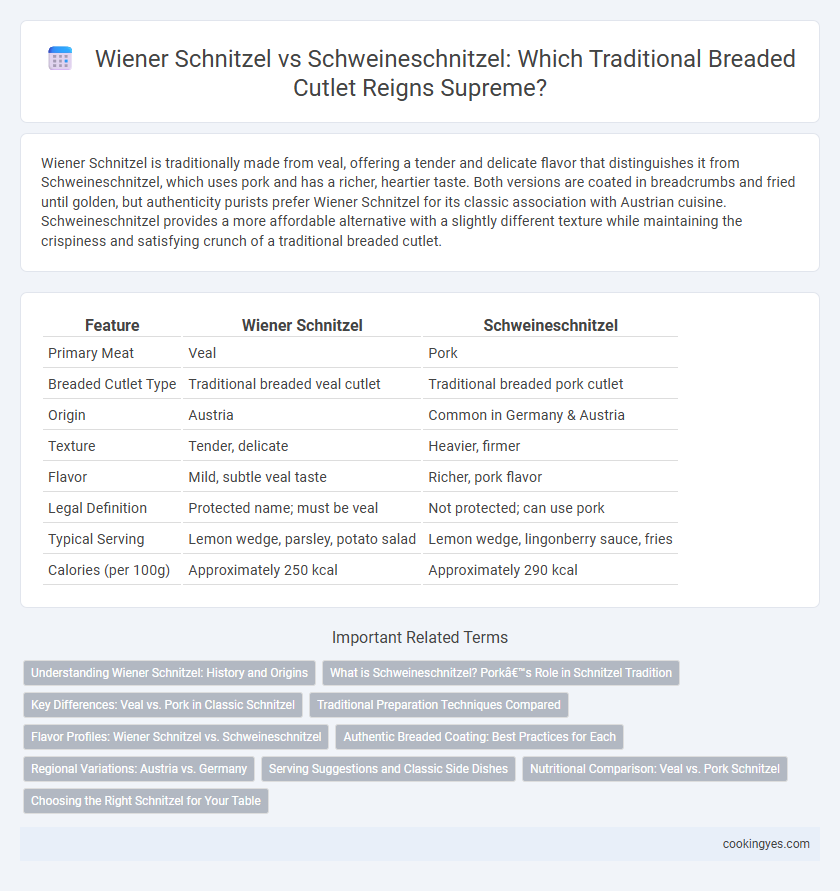Wiener Schnitzel is traditionally made from veal, offering a tender and delicate flavor that distinguishes it from Schweineschnitzel, which uses pork and has a richer, heartier taste. Both versions are coated in breadcrumbs and fried until golden, but authenticity purists prefer Wiener Schnitzel for its classic association with Austrian cuisine. Schweineschnitzel provides a more affordable alternative with a slightly different texture while maintaining the crispiness and satisfying crunch of a traditional breaded cutlet.
Table of Comparison
| Feature | Wiener Schnitzel | Schweineschnitzel |
|---|---|---|
| Primary Meat | Veal | Pork |
| Breaded Cutlet Type | Traditional breaded veal cutlet | Traditional breaded pork cutlet |
| Origin | Austria | Common in Germany & Austria |
| Texture | Tender, delicate | Heavier, firmer |
| Flavor | Mild, subtle veal taste | Richer, pork flavor |
| Legal Definition | Protected name; must be veal | Not protected; can use pork |
| Typical Serving | Lemon wedge, parsley, potato salad | Lemon wedge, lingonberry sauce, fries |
| Calories (per 100g) | Approximately 250 kcal | Approximately 290 kcal |
Understanding Wiener Schnitzel: History and Origins
Wiener Schnitzel is a traditional Austrian breaded cutlet made exclusively from veal, reflecting its historical roots in Viennese cuisine dating back to the 19th century. Unlike Schweineschnitzel, which uses pork, authentic Wiener Schnitzel adheres to strict regulations protecting its origin and preparation methods, highlighting veal's tender texture and delicate flavor. Understanding these distinctions emphasizes the cultural and culinary significance of Wiener Schnitzel as a symbol of Austrian heritage.
What is Schweineschnitzel? Pork’s Role in Schnitzel Tradition
Schweineschnitzel is a traditional German breaded cutlet made from pounded pork loin, coated in breadcrumbs, and fried to golden perfection. Unlike Wiener Schnitzel, which is exclusively made from veal, Schweineschnitzel highlights pork's significant role in the schnitzel tradition, offering a tastier and more affordable alternative popular across Germany. Pork's versatility and availability have cemented Schweineschnitzel as a staple, balancing rich flavor with the classic crispy texture synonymous with schnitzel dishes.
Key Differences: Veal vs. Pork in Classic Schnitzel
Wiener Schnitzel is traditionally made from veal, offering a tender texture and delicate flavor that defines the classic Austrian specialty. Schweineschnitzel uses pork, resulting in a slightly richer taste and firmer bite, often preferred for budget-friendly meals. The key difference lies in the meat choice, which affects flavor intensity, texture, and traditional authenticity of the schnitzel.
Traditional Preparation Techniques Compared
Wiener Schnitzel is traditionally made from veal, thinly pounded and coated in a mixture of flour, beaten eggs, and fine breadcrumbs before being shallow-fried in clarified butter until golden and crisp. Schweineschnitzel, while similarly breaded and fried, typically uses pork loin or tenderloin, often marinated briefly to enhance tenderness and flavor. The key difference lies in the veal's delicate texture requiring a lighter touch during breading and frying, whereas Schweineschnitzel allows for a slightly heartier crust and longer frying time to achieve optimal juiciness.
Flavor Profiles: Wiener Schnitzel vs. Schweineschnitzel
Wiener Schnitzel, made from tender veal, offers a delicate, slightly sweet flavor with a light, crispy breadcrumb coating that enhances its subtle meatiness. Schweineschnitzel, typically prepared with pork, has a heartier, richer taste and a juicier texture, complemented by a more robust and savory breadcrumb crust. The choice between Wiener Schnitzel and Schweineschnitzel depends on flavor preference, with veal providing elegance and mildness, while pork delivers a satisfying, bold character.
Authentic Breaded Coating: Best Practices for Each
Wiener Schnitzel uses veal with a delicate, authentic breaded coating made from finely ground breadcrumbs, eggs, and flour, ensuring a light, crispy texture. Schweineschnitzel employs pork, demanding coarser breadcrumbs and a thicker coating to maintain juiciness and enhance flavor. Proper chilling of the meat and avoiding over-handling the coating mixture are best practices that preserve the Schnitzel's traditional crunch and tenderness for each variant.
Regional Variations: Austria vs. Germany
Wiener Schnitzel, a traditional Austrian dish, is made exclusively from veal and follows strict regional regulations protecting its authenticity, especially in Vienna where it holds cultural significance. In contrast, Germany's Schweineschnitzel uses pork, reflecting local preferences and budget considerations, often appearing in various regional varieties such as Schnitzel Wiener Art, which mimics the Austrian style but with pork. These regional differences highlight culinary heritage: Austria's Wiener Schnitzel emphasizes veal and protected designation, while Germany embraces pork-based versions with diverse seasoning and preparation methods.
Serving Suggestions and Classic Side Dishes
Wiener Schnitzel, traditionally made from veal, is typically served with a lemon wedge and accompanied by classic side dishes such as potato salad, cucumber salad, or lingonberry sauce. Schweineschnitzel, made from pork, pairs well with hearty sides like mashed potatoes, sauerkraut, or spaetzle to complement its richer flavor. Both variations favor simple, fresh garnishes like parsley and are often enjoyed with a crisp white wine or pilsner for an authentic Central European meal experience.
Nutritional Comparison: Veal vs. Pork Schnitzel
Wiener Schnitzel, made from veal, typically contains fewer calories and less fat compared to Schweineschnitzel, which uses pork. Veal tends to be leaner with higher protein content and lower saturated fat, making Wiener Schnitzel a lighter choice for a traditional breaded cutlet. Schweineschnitzel provides richer flavor but often has increased calories and fat due to the marbling in pork meat.
Choosing the Right Schnitzel for Your Table
Wiener Schnitzel, made from veal, offers a tender texture and authentic Austrian flavor, making it a premium choice for traditional breaded cutlets. Schweineschnitzel, crafted from pork, provides a more affordable and versatile option while maintaining a crispy, golden crust. Selecting the right schnitzel depends on your preference for veal's delicate taste or pork's heartier profile, ensuring a satisfying meal tailored to your table.
Wiener Schnitzel vs Schweineschnitzel for traditional breaded cutlet Infographic

 cookingyes.com
cookingyes.com